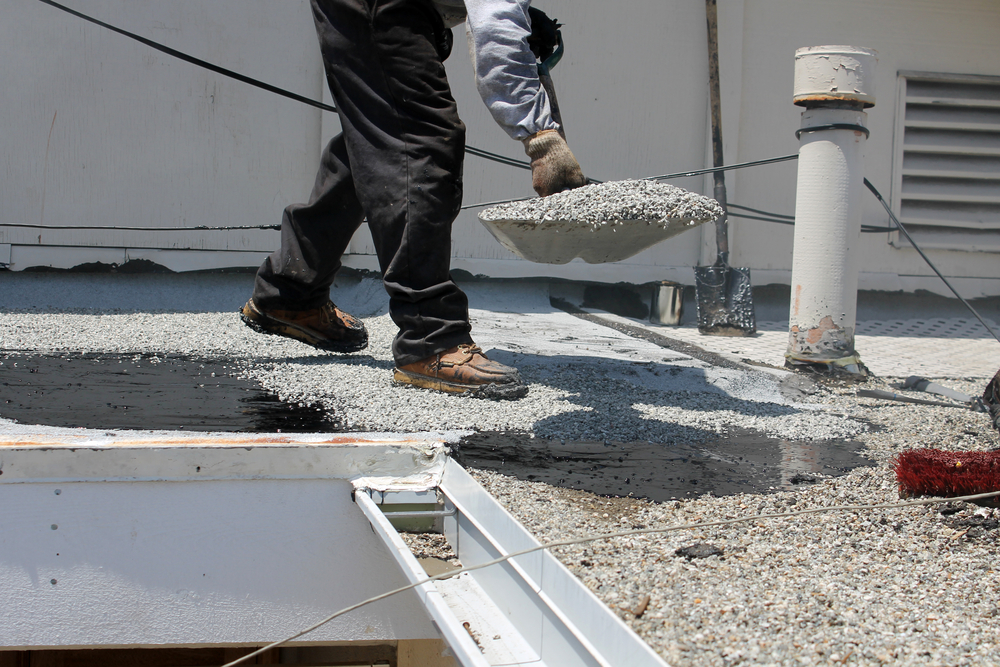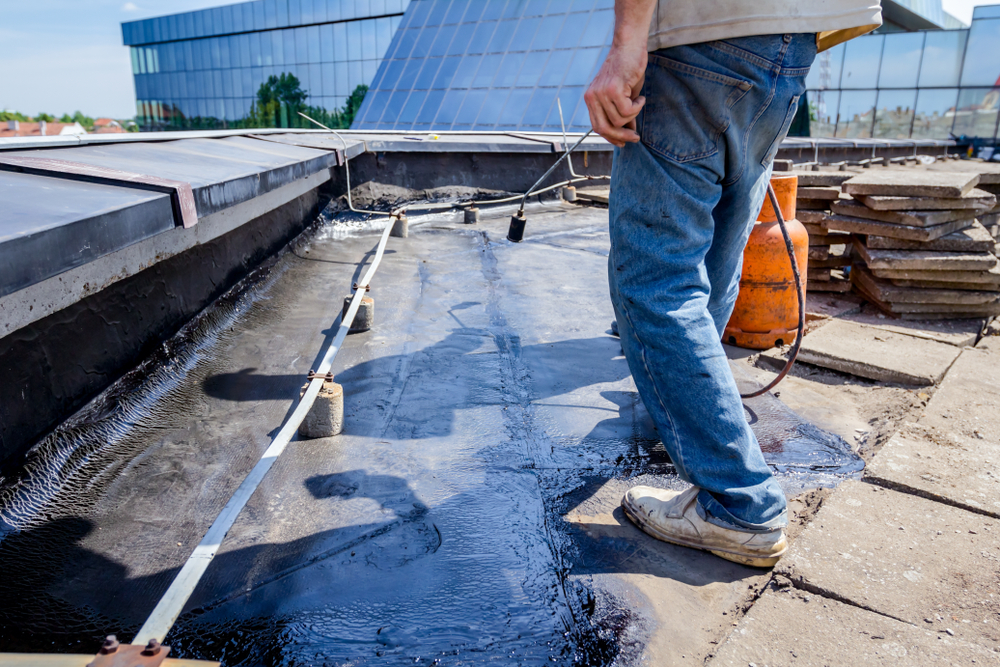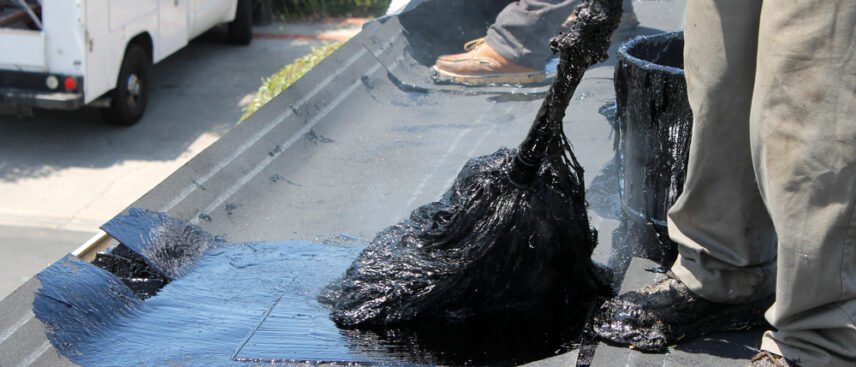Built-up roofs are a staple in the roofing industry, most commonly used for flat and low-slope roofs. These roofs are nothing new — they’ve been around for over a century! In that time, they’ve been a reliable choice, offering waterproof benefits for commercial, industrial, and some residential buildings.
Understanding BUR Systems
A built-up roofing (BUR) system is a layered roof made from a handful of materials: bitumen (asphalt) and ply sheets (reinforcing fabrics). The bitumen is applied blazing hot, alternating each layer with ply sheets. This results in fused layers that offer impressive redundant waterproof protection.
On the very top of those layers is a coating of a mineral-surfaced cap sheet or a flood coat of asphalt with embedded gravel for ballast. People typically choose the mineral-surfaced cap for its UV protection and aesthetically pleasing looks, while others choose the gravel-embedded flood coat for its weight, which stabilizes the roof system and keeps it in place.
Benefits of Built-Up Roofing

Compared to other types of roofing, built-up roofing systems offer all sorts of perks, including:
Durability
Given its layered construction, this hot tar roofing option is incredibly durable. It can last 20 to 30 years or more, provided you hire a qualified contractor to properly install and routinely maintain it throughout its lifespan. While it won’t last forever, its remarkable lifespan and durability ensure you’ll get the most bang for your buck.
Waterproofing
The fused layers of bitumen and ply sheets create a multi-layer waterproof roof. Since the asphalt is scorching hot when it’s applied, the sealed, finished product is completely waterproof and ready to protect your roof.
Fire Resistance
As a business or homeowner, it’s important you’re prepared for potential fires. While BUR roofs aren’t fire-proof, they’re impressively fire-resistant. They have the highest roofing assembly fire ratings available: FM1 Class 1 and UL Class A. So, compared to many other options out there, BUR roofing is a clear winner in the fire resistance category.
Versatility
BUR roofs are versatile enough to accommodate all sorts of unique projects, whether you have an unusually-shaped roof or an out-of-the-box configuration. With proper detailing, your contractor can adapt the roofing system to accommodate your roof’s shape and configuration.
Proven Track Record
If you want something known to be highly dependable, BUR systems are a solid pick. Home and business owners worldwide have used this system for over a century. It’s long been a reliable choice, so if a proven track record is a must, considering BUR roofing for your business or home is not a bad idea.
Considerations for BUR Roofing
While BUR roofing is undoubtedly a phenomenal choice for flat and low-slope roofs, there are a couple of things you should consider before committing to one for your home or business:
Weight
Built-up roofing is fairly hefty. It packs a staggering amount of weight into each square foot, usually weighing between five and seven pounds per square foot. This is a big jump from the one-pound-per-square-foot average of single-ply roofs. Over an entire roof, that weight can be quite the burden, so these roofs demand a robust, structurally sound roof deck.
Maintenance
Every roof requires maintenance from time to time — there’s no escaping that. Compared to other flat roof materials, BUR roofs might require more frequent inspections and maintenance. However, in the grand scheme of roofing maintenance, these roofs are fairly easy to maintain.
Installation Complexity
Between the layered construction and heavy weight of BUR roofs, installing these roofs is no walk in the park. You’ll need to enlist help from a skilled roofing contractor with experience and knowledge of these roofs. This way, you won’t have to stress about them using improper techniques or installing your new roof incorrectly.
Environmental Factors
The hot asphalt in BUR roofing systems is a must to achieve the sought-after finish, but extremely hot climates can make the installation a nightmare. The temperature helps meld the layers together to create a waterproof result, but it can also make installation a challenge. It can cause problems with the asphalt’s viscosity and workability. It can even demand extra precautions for the workers and additional planning to make sure the asphalt bonds.
Installation Process of BUR Roofs

Like any successful roofing project, properly installing a BUR roof starts with prep. Your contractor will look at the roof deck to ensure it’s clean, level, and structurally sound. If they find any issues, they’ll address them accordingly.
Once everything looks good, your contractor will start on the base sheet application. That layer provides a solid, smooth foundation for the following layers. With that in place, your contractor will apply alternating layers of bitumen and ply sheets to create a waterproof membrane. They’ll use heated bitumen and sandwich ply sheets between them to achieve the desired waterproof result.
In the final step, your contractor will add the finishing touches. If you want an aesthetically pleasing finish, you might opt for the mineral-surfaced cap. Or, you might opt for a flood coat of asphalt with embedded gravel for ballast. Either way, your contractor will finish up by adding your chosen top layer.
Maintenance and Repair of BUR Roofs
Your new BUR roof, much like any other part of the building, will require a bit of attention from time to time. Routine maintenance and occasional repairs will help you keep your roof in tip-top shape.
On the maintenance side of the story, you should have a roofing pro take a look at your roof at least once a year. They’ll inspect it for things that could become an issue later down the road, like cracks, blisters, or loose seams (especially around penetrations).
That routine inspection can help nip those problems in the bud, helping you avoid expensive and hard-to-repair issues that could arise. If they find anything of concern, like punctures or tears, they’ll take care of it. These repairs often involve patching materials or asphalt cement, but it can vary based on the specifics of your project.
If they find something serious or extensive, you might need to look into a total roof replacement. Repairs can’t always remedy the issue, so if they find something that needs more than a little TLC, chat with a qualified roofing pro to examine your roof.
There’s so much more to learn about BUR systems — this is just the tip of the iceberg! More research can help you learn more about these roofs and whether they’re a good fit for your needs. Of course, if you’re not sure whether a BUR roof fits your building requirements, talk to a qualified local roofing contractor. They’ll evaluate your roof and help you determine what roofing material best suits your needs.
